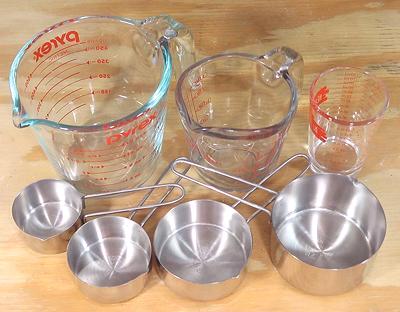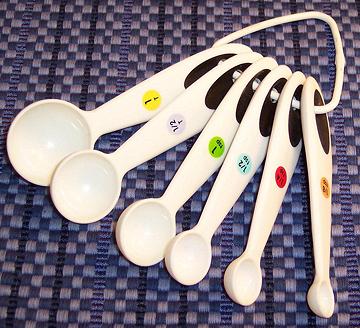 Measuring cups come in two styles - Liquid and Dry. The dry are particularly
important for people doing baking, because recipe measures there are critical,
and stupid cookbook publishers won't let the recipe writers use weights, which
are much more accurate. Being able to shave off to rim level with a knife
makes dry measuring much more accurate than in graduated liquid measures.
Measuring cups come in two styles - Liquid and Dry. The dry are particularly
important for people doing baking, because recipe measures there are critical,
and stupid cookbook publishers won't let the recipe writers use weights, which
are much more accurate. Being able to shave off to rim level with a knife
makes dry measuring much more accurate than in graduated liquid measures.
I have read "expert" advice that one must not use the dry measures for liquids because there can be a meniscus (liquid level higher than the rim) "up to 30% of the volume". First, that 30% is absurd, and if you can't manage a silly meniscus by watching your fill, or simply pouring off a dash of the liquid, perhaps cooking isn't really your thing.
For more on measures see our
Measures & Converesions page.
For more on Kitchen Gear.
 I do not accept measuring spoon sets that do not include 1/8 teaspoon
size. It is a size common in recipes, or if you divide recipes into
smaller amounts. Not having it also makes judging 1/16 teaspoon difficult.
This is especially important for Indian cooking if you are using Pure
Asafoetida (not Asafoetida Powder, which is diluted with rice flour). Pure
Asafoetida is used in very small quantities.
I do not accept measuring spoon sets that do not include 1/8 teaspoon
size. It is a size common in recipes, or if you divide recipes into
smaller amounts. Not having it also makes judging 1/16 teaspoon difficult.
This is especially important for Indian cooking if you are using Pure
Asafoetida (not Asafoetida Powder, which is diluted with rice flour). Pure
Asafoetida is used in very small quantities.
The photo shows the the spoons on a ring, but I would remove them from the ring and toss the ring. I would reject any set that could not be removed from its ring, or is fastened together by some other means. Having them together makes using them very clumsy.
The set in the photo is an old Oxo set, made before the company decided
that all kitchen equipment should be black.